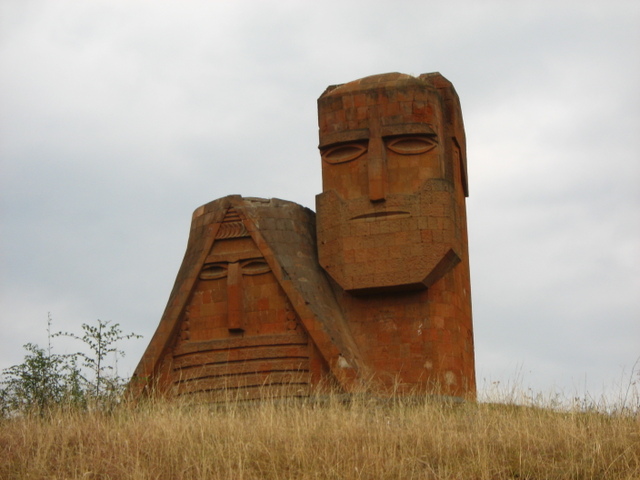When the change happened that brought about all this, we do not know. It was thousands of years ago that the Aryan people began their march out of their old country in mid-Asia. But from the remains of their language and the likeness of their legends to those amongst other nations, we do know that ages and ages ago their country grew too small for them, so they were obliged to
move away from it. They could not go eastward, for the great mountains shut them in; they could not go northward, for the great desert was too barren for their flocks and herds. So they turned, some of them southward into India and Persia, and some of them westward into Europe--at the time, perhaps, when the land of Europe stretched from the borders of Asia to our own islands, and when there was no sea between us and what is now the mainland. How they made their long and toilsome march we know not. But, as Kingsley writes of such a movement of an ancient tribe, so we may fancy these old Aryans marching westward--"the tall, bare-limbed men, with stone axes on their shoulders and horn bows at their backs, with herds of grey
cattle, guarded by huge lop-eared mastiffs, with shaggy white horses, heavy-horned sheep and silky goats, moving always westward through the boundless steppes, whither or why we know
not, but that the All-Father had sent them forth. And behind us [he makes them say] the rosy snow-peaks died into ghastly grey, lower and lower, as every evening came; and before us the plains spread infinite, with gleaming salt-lakes, and ever-fresh tribes of gaudy flowers. Behind us, dark: lines of living beings streamed down the mountain slopes; around us, dark lines crawled
along the plains--westward, westward ever. Who could stand against us? We met the wild asses on the steppe, and tamed them, and made them our slaves. We slew the bison herds, and swam
broad rivers on their skins. The Python snake lay across our path; the wolves and wild dogs snarled at us out of their coverts; we slew them and went on. The forests rose in black tangled barriers, we hewed our way through them and went on. Strange giant tribes met us, and eagle-visaged hordes, fierce and foolish; we smote them, hip and thigh, and went on, west-ward ever." And so, as they went on, straight towards the west, or as they turned north and south, and thus overspread new lands, they brought with them their old ways of thought and forms of belief, and the stories in which these had taken form; and on these were built up the Gods and Heroes, and all wonder-working creatures and things, and the poetical fables and fancies which have come down to us, and which still linger in our customs and our Fairy Tales bright and sunny and many
coloured in the warm regions of the south; sterner and wilder and rougher in the north; more homelike in the middle and western countries; but always alike in their main features, and
always having the same meaning when we come to dig it out; and these forms and this meaning being the same in the lands of the Western Aryans as in those still peopled by the Aryans of the East. It would take a very great book to give many examples of the myths and stories which are alike in all the Aryan countries; but we may see by one instance what the likeness is; and it shall be a story which all will know when they read it.
Мы не знаем, когда произошло изменение, которое привело к этому. Случилось это тысячи лет назад, когда арийцы начали свой путь из своей старой страны в Центральной Азии. Но из того, что сохранилось на их языке, и сходстве их легенд с легендами других наций, мы наверняка знаем, что много сотен лет назад их страна стала для них мала, поэтому они были вынуждены покинуть ее. Они не могли пойти на восток, так как их путь преграждали высокие горы, они не могли пойти на север, так как огромная пустыня не могла прокормить их стада и народ. Поэтому они свернули, некоторые из них на юг в Индию и Персию, некоторые – на запад в Европу – в те времена, возможно, когда территория Европы простиралась от границ Азии до наших островов, и когда не было моря между нами и тем, что сейчас является материком. Как им удалось проделать долгий и утомительный путь – мы не знаем. Однако, как Кингсли писал о подобном передвижении древнего народа, мы можем представить этих древних арийцев, идущих на запад – «высокие, полуобнаженные мужчины, с каменными осями на плечах и роговыми дугами на спинах, со стадами серого скота, охраняемого огромными вислоухими мастиффами, с лохматыми белыми лошадьми, овцами с тяжелыми рогами и гладкими козлами, передвигающиеся всегда на запад сквозь безграничные степи, куда и почему, мы не знаем, но мы знаем, что Отец Небесный послал их туда. И позади нас (он завтавляет их говорить) розовые снежные вершины исчезали в ужасно сером цвете, все ниже и ниже, с приходом каждых сумерек, и впереди нас простирались безграничные равнины со сверкающими солеными озерами и всегда цветущими зарослями ярких цветов. Позади нас, темные шеренги живых существ спускались вниз со склонов гор; вокруг нас, темные шеренги с трудом передвигались вдоль равнин – на запад, всегда на запад. Кто мог остановить нас? Нам встречались дикие ослы в степях, и мы приручали их, делали их своими рабами. Мы убивали стада бизонов и переплывали широкие реки на их шкурах. Питон преграждал нам путь, волки и дикие собаки динго рычали на нас из своих укрытий, мы убивали их и продолжали свой путь. Леса появлялись как черные заросли-барьеры, мы прорубали себе дорогу сквозь них и продолжали свой путь. Чужие огриные племена встерились нам, похожие наорлов толпы, жестокие и безрассудные, мы обрушились на них беспощадно и продолжали идти только ан запад». Таким образом, пока они шли, прямо на запад, или когда они поворачивали на север или на юг, распространяясь на новые земли, они приносили с собой старые образы мышления и формы веры, и истории, из которых они сформировались, и на которых были созданы Боги и Герои, и все чудотворные существа, и вещи, и поэтичные мифы, и фантазии, которые дошли до наших времен, и которые все еще сохранились в наших традициях и Сказках: яркие и солнечные, и разноцветные в теплых южных районах, более строгие и жесткие, и грубые на севере, более дружественные в центральных и западных странах, но всегда похожие по основным параметрам, и всегда имеющие одно и тоже значение, когда мы докапываемся до него, и эти формы и значения, одинаковые на территории западных арийцев и на тех территориях, все еще заселенных восточными арийцами. Можно было написать целую книгу, чтобы привести множество примеров мифов и историй, которые имеют сходство во всех арийских странах, но мы можем рассмотреть на одном примере, в чем состоит сходство, и эту историю при прочтении узнают абсолютно все.
Once upon a time there was a Hindu Rajah, who had an only daughter, who was born with a golden necklace. In this necklace was her soul; and if the necklace were taken off and worn by
some one else, the Princess would die. On one of her birthdays the Rajah gave his daughter a pair of slippers with ornaments of gold and gems upon them. The Princess went out upon a mountain to pluck the flowers that grew there, and while she was stooping to pluck them one of her slippers came off and fell down into a forest below. A Prince, who was hunting in the forest, picked up the lost slipper, and was so charmed with it that he desired to make its owner his wife. So he made his wish known everywhere, but nobody came to claim the slipper, and the poor Prince grew very sad. At last some people from the Rajah's country heard of it, and told the Prince where to find the Rajah's daughter; and he went there, and asked for her as his wife, and they were married. Sometime after, another wife of the Prince, being jealous of the Rajah's daughter, stole her necklace, and put it on her own neck, and then the Rajah's daughter died. But her body did not decay, nor did her face lose its bloom; and the Prince went every day to see her, for he loved her very much although she was dead. Then he found out the secret of the necklace, and got it back again, and put it on his dead wife's neck, and her soul was born again in her, and she came back to life, and they lived happy ever after.
Жил-был когда-то Хинду Раджа, у которого была одна единственная дочь, которая родилась с золотым ожерельем. В этом ожерелье была ее душа, и если ожерелье снять с шеи и одеть кому-нибудь другому, принцесса бы умерла. На один из ее дней рождений Раджа подарил дочери пару туфель с золотым рисунком и драгоценными камнями. Принцесса пошла высоко в горы собирать цветы, которые там росли, и когда она наклонилась, чтобы сорвать цветок, одна туфелька соскользнула с ее ноги и упала в кусты, которые росли внизу. Принц, охотившийся в лесу, подобрал потерянную туфельку и был так очарован ею, что пожелал взять в жены ее владелицу. Так, он объявил повсюду о своем намерении, но никто не пришел за туфелькой, поэтому Принцу стало очень грустно. Наконец, некоторые люди из округи Раджи прознали об этом и рассказали Принцу, где найти дочь Раджи. Он пошел туда и попросил ее руки. Они поженились. Некоторое время спустя, другая жена принца, которая ревновала его к дочери Раджи, украла ее ожерелье и одела его себе на шею,. Вскоре дочь Раджи умерли. Но тело ее не разлагалось и лицо не потеряло прежнего румянца, а принц приходил к ней каждый день повидать ее, потому что он ее сильно любил, не смотря на то, что она была мертва. Затем он узнал секрет ожерелья и вернул его, одел его на шею жены, и ее душа снова поселилась в ней. Она вернулась к жизни и жили они долго и счастливо.
This Hindu story of the lost slipper is met with again in a legend of the ancient Greeks, which tells that while a beautiful woman, named Rhodope--or the rosy-cheeked--was bathing, an eagle
picked up one of her slippers and flew away with it, and carried it off to Egypt, and dropped it in the lap of the King of that country, as he sat at Memphis on the judgment-seat. The slipper was so small and beautiful that the King fell in love with the wearer of it, and had her sought for, and when she was found he made her his wife. Another story of the same kind. It is found in many countries, in various forms, and is that of Cinderella, the poor neglected maiden, whom her stepmother set to work in the kitchen, while her sisters went to the grand balls and feasts at the King's palace. You know how Cinderella's fairy godmother came and dressed her like a princess, and sent her to the ball; how the King's son fell in love with her; how she lost one of her slippers, which the Prince picked up; how he vowed that he would marry the maiden who could fit on the lost slipper; how all the ladies of the court tried to do it, and failed, Cinderella's sisters amongst them; and how Cinderella herself put on the slipper, produced the fellow to it, was married to the King's son, and lived happily with him.
Эта индийская история о потерянной туфельке встречается снова в легенде древних греков, в которой говорится, что пока красавица по имени Родопе – или розовощекая- принимала ванну, орел украл одну из ее туфелек и улетел с ней. Прилетел с ней в Египет и бросил на колени короля той страны, когда тот сидел в Мэмфисе в своем троне. Туфелька была такой изящной и красивой, что Король влюбился в ее владелицу, послал людей разыскать ее, и когда ее нашли, он на ней женился. Другая похожая история встречается во многих странах в разных формах, называется она историей о Золушке. Эта история о бедной, отвергнутой девушке, которую мачеха заставляла работать на кухне, в то время пока ее сестры ходили на балы и празднования во дворце короля. Вы знаете, как добрая фея Золушки, ее крестная мать, приехала и одела ее как принцессу. Она отправила ее на бал, где в нее влюбился сын короля, и она потеряла одну туфельку, которую подобрал принц. Он провозгласил, что возьмет в жены ту девушку, которой подойдет эта туфелька. И все девушки двора примеряли ее, и никому эта туфелька не подошла, в том числе и сестрам Золушки. Золушка примерила туфельку и вышла замуж за сына короля. И жили они вместе долго и счастливо.


















